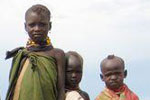As the UN announces that famine has spread in Somalia to three additional regions (making five in total now), the US has put the first number to the amount of children under 5 who have so far perished from starvation in the last 90 days: 29,000. Nearly half of the total population of Somalia is currently in need of emergency food assistance. Yet, the al Qaeda-linked group al-Shabab, which controls parts of Somalia, has made bringing assistance to many of the malnourished incredibly difficult, if not impossible. The famine in Somalia has been brought-on by lack of governance combined with crippling droughts throughout East Africa, which some experts have linked to climate change. High food prices worldwide and a lagging response by the international community and donors have made matters only worse.
“Despite increased attention in recent weeks, current humanitarian response remains inadequate, due in part to ongoing access restrictions and difficulties in scaling‐up emergency assistance programs, as well as funding gaps. As a result, famine is expected to spread across all regions of the south in the coming four to six weeks and is likely to persist until at least December 2011,” reads a press release from the Famine Early Warning Systems Network.
According to some reports, al-Shabaab has been working to stop refugees from escaping Somalia into neighboring Kenya. Some refugees may even have been killed by al-Shabaab militants. Still, hundreds of thousands of Somalians have reached Kenya, overwhelming camps and emergency assistance there. One camp called Dadaab was built for a capacity of 90,000 people, but is currently holding over 420,000 people. There are stories of women arriving with dead infants or children perishing soon after arrival. Heroic efforts in camp, however, have saved scores of lives. Refugees from southern Somalia are also pouring into the capital of Mogidishu.
“There’s no doubt that lives have been lost, but there are many, many more that will be saved if the world responds as it must,” Mark Bowden, the UN’s humanitarian coordinator for Somalia, said.
The drought is impacting people across the region, some 12 million people in total are in need of assistance from Kenya, Ethiopia, Uganda, and Dijbouti, as well as Somalia. Observers have warned that the famine could spread beyond Somalia into other countries if more assistance is not provided.
A conference by the African Union meant to raise money for the victims of the famine has been postponed two weeks until August 25th.
Climate change link?
The direct cause of the famine, aside from complete government break-down in Somalia, is the failure of the past two rainy seasons in East Africa leading to drought. Livestock and staple crops throughout the region have been decimated. Food prices have sky-rocketed to record levels, leaving many without their usual livelihoods (livestock) or access to food markets.
Drought is a regular occurrence in East Africa and communities have long-adapted to dry conditions, however some say recent droughts may be worsening due to climate change. Unfortunately climate models regarding rainfall in the region have told two different stories: some models have predicted more rainfall in the region, while others have predicted less. However, even if previous studies are right and East Africa will see more rainfall instead of less, it’s likely to come in bigger bursts—i.e. floods—instead of the regular precipitation needed for staple agriculture in such an arid region.
One recent study in Climate Dynamics, however, has determined that climate change is creating more drought condition in East Africa.
“Global temperatures are predicted to continue increasing, and we anticipate that average precipitation totals in Kenya and Ethiopia will continue decreasing or remain below the historical average,” said USGS scientist Chris Funk. “The decreased rainfall in eastern Africa is most pronounced in the March to June season, when substantial rainfall usually occurs. Although drought is one reason for food shortages, it is exacerbated by stagnating agricultural development and continued population growth.”
Populations in parts of East Africa have sky-rocketed in recent decades, a trend which may be overwhelming agricultural and livestock productivity in such a marginal and impoverished region.
Related articles
Chart: US suffers record drought
(08/01/2011) An exceptional drought is still scorching major parts of Texas, New Mexico, Oklahoma, and Louisiana. A new report from the National Drought Mitigation Center finds that over July, nearly 12 percent of the US saw exceptional drought conditions, the highest record since monitoring began a dozen years. Exceptional drought is the worst possible on a 5-scale drought scale.
Adaptation, justice and morality in a warming world

(07/28/2011) If last year was the first in which climate change impacts became apparent worldwide—unprecedented drought and fires in Russia, megaflood in Pakistan, record drought in the Amazon, deadly floods in South America, plus record highs all over the place—this may be the year in which the American public sees climate change as no longer distant and abstract, but happening at home. With burning across the southwest, record drought in Texas, majors flooding in the Midwest, heatwaves everywhere, its becoming harder and harder to ignore the obvious. Climate change consultant and blogger, Brian Thomas, says these patterns are pushing ‘prominent scientists’ to state ‘more explicitly that the pattern we’re seeing today shows a definite climate change link,’ but that it may not yet change the public perception in the US.
Tens of thousands starving to death in East Africa
(07/20/2011) As the US media is focused like a laser on theatric debt talks and the UK media is agog at the heinous Rupert Murdoch scandal, millions of people are undergoing a starvation crisis in East Africa. The UN has upgraded the disaster—driven by high food prices, conflict, and prolonged drought linked by some to climate change—to famine in parts of Somalia today. Mark Bowden, UN humanitarian coordinator for Somalia, has said that tens of thousands Somalis have died from malnutrition recently, “the majority of whom were children.”














